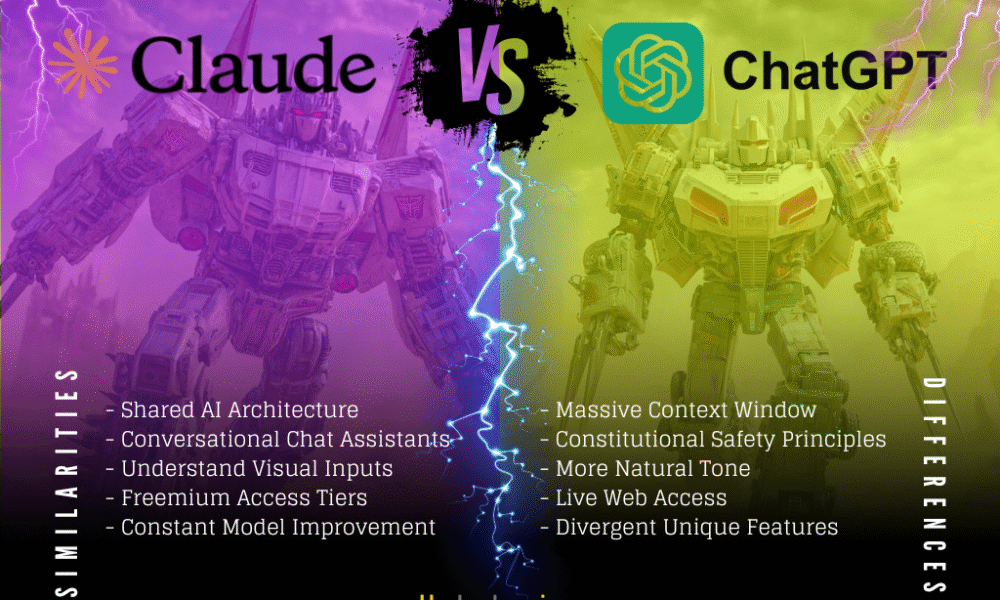AI
Claude vs. ChatGPT: Key Advantages of Anthropic’s AI

Claude vs. ChatGPT
While both Claude, developed by Anthropic, and ChatGPT, from OpenAI, are powerful large language models at the forefront of artificial intelligence, Claude possesses several distinct advantages that make it a compelling choice for specific users and applications. These benefits primarily revolve around its massive context window, constitutional AI principles, and a more natural-feeling conversational ability.
One of Claude’s most significant differentiators is its substantially larger context window. The latest version, Claude 3, boasts a context window of up to 200,000 tokens, equivalent to approximately 150,000 words or over 500 pages of text. This dwarfs the context window of even the most advanced versions of ChatGPT. This extensive memory allows Claude to process and analyze vast amounts of information in a single prompt, making it exceptionally well-suited for tasks such as summarizing lengthy reports, analyzing complex legal documents, or maintaining coherence in long, intricate conversations. For users who need an AI to grasp the nuances of extensive textual data, Claude’s superior context handling is a clear advantage.
Anthropic’s commitment to developing a “constitutional AI” also sets Claude apart. This approach involves training the AI on a set of core principles designed to ensure its outputs are helpful, harmless, and honest. This emphasis on ethical and safe AI behavior can result in more reliable and less prone to generating problematic or biased content. While OpenAI also invests heavily in safety measures, Anthropic’s foundational focus on a constitutional framework is a core tenet of Claude’s design and a key benefit for users concerned with the ethical implications of AI.
In terms of conversational fluency, many users report that Claude’s responses feel more natural and less “robotic” than those of ChatGPT. It often excels at creative writing tasks, generating more nuanced and human-sounding prose. This can be attributed to its training and architectural choices, which prioritize a more thoughtful and context-aware conversational style.
Furthermore, for developers and those working with code, Claude offers a feature called “Artifacts.” This allows users to see, interact with, and build upon the code generated by the AI in a dedicated window, creating a more integrated and efficient workflow. While ChatGPT is also a capable coding assistant, Claude’s Artifacts provide a more seamless and user-friendly experience for iterative development.
Finally, in some head-to-head comparisons and benchmarks, different versions of Claude have demonstrated superior performance in specific areas, such as certain reasoning tasks and standardized exams. While the performance of both models is constantly evolving with new updates, Claude has proven to be a formidable competitor and, in some instances, a more capable tool for particular intellectual challenges.
In conclusion, while ChatGPT remains a versatile and widely used AI assistant, Claude offers compelling advantages in its massive context window, its foundational commitment to ethical AI principles, its natural conversational style, and its developer-friendly features. For users who prioritize these specific capabilities, Anthropic’s Claude presents a powerful and increasingly popular alternative.
Similarities
- Core Technology: Both are advanced Large Language Models (LLMs) based on the transformer architecture, designed for natural language understanding and generation.
- Primary Function: They are both general-purpose conversational AI assistants capable of a wide range of tasks, including answering questions, writing essays, summarizing text, generating code, and creative writing.
- Multimodality: Both models have versions that are multimodal, meaning they can understand and process not just text but also visual inputs like images and documents.
- Accessibility: Both offer a free tier for general use and more powerful, feature-rich subscription models (Claude Pro, ChatGPT Plus/Team/Enterprise) for advanced users.
- Continuous Development: Both are under constant development by their respective companies (Anthropic and OpenAI), with frequent updates that improve their capabilities, accuracy, and safety.
Differences
- Context Window: This is Claude’s most significant advantage. The Claude 3 models offer a 200,000 token context window, allowing them to process and recall information from extremely long documents (approx. 150,000 words), while ChatGPT’s context window is considerably smaller.
- AI Safety Philosophy: Claude is built on a “Constitutional AI” framework, where it’s trained to align its responses with a core set of principles (a “constitution”). ChatGPT primarily uses Reinforcement Learning from Human Feedback (RLHF), relying more on human reviewers to guide its behavior.
- Conversational Tone: Many users find Claude’s conversational style to be more natural, reflective, and less overtly “AI-like.” ChatGPT’s tone can sometimes be more direct and structured, though this can be modified with custom instructions.
- Real-Time Web Access: ChatGPT, particularly in its paid versions, can browse the live internet to provide up-to-the-minute information and cite current sources. Claude’s knowledge is generally limited to its training data, which has a specific cutoff date.
- Ecosystem and Features:
- ChatGPT has a more mature ecosystem with features like Custom GPTs (allowing users to create specialized versions of the chatbot) and a vast library of third-party plugins.
- Claude offers unique features like Artifacts, which provides a dedicated workspace to view, edit, and iterate on generated content like code snippets or documents directly within the interface.
- Performance on Specific Tasks: While both are highly capable, they exhibit different strengths. At its launch, Claude 3 Opus surpassed GPT-4 on several industry benchmarks for reasoning and knowledge. Anecdotally, users often prefer Claude for long-form creative writing and summarizing massive texts, while ChatGPT’s broader ecosystem and web access make it a powerful tool for research and specialized tasks.
Visit our AI Reviews section for more great info.